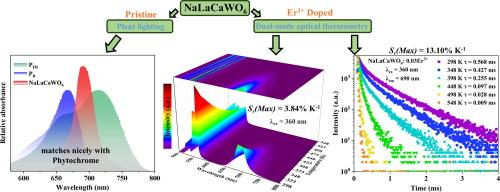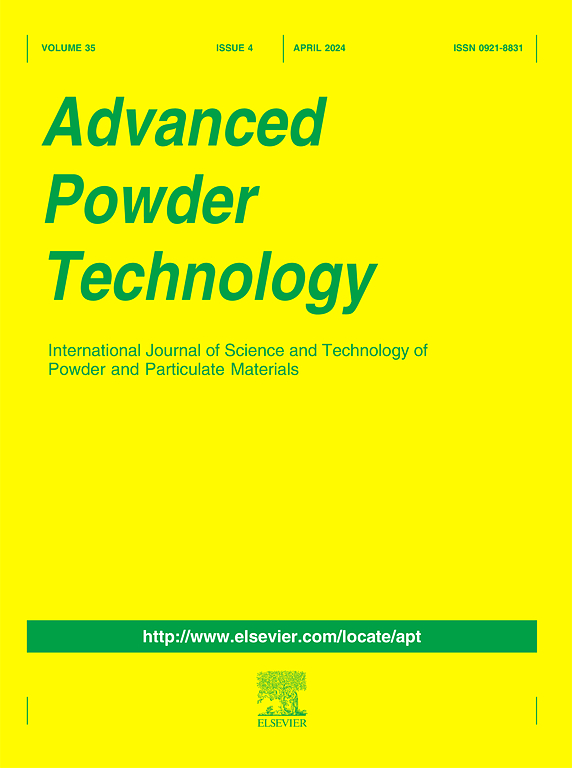Self deep red luminescence in NaLaCaWO6 double perovskite, properties regulation via Er3+ doping, and applications in favorable optical thermometry with ultra high relative sensitivity and plant lighting
IF 4.2
2区 工程技术
Q2 ENGINEERING, CHEMICAL
引用次数: 0
Abstract
Self deep red emission was found for the first time in NaLaCaWO6 double perovskite which was synthesized via solid-state reaction, and the luminescence was effectively enhanced and regulated via Er3+ doping. A comprehensive analysis of the calcination atmosphere dependent photoluminescence, X-ray photoelectron spectroscopy, and electron paramagnetic resonance revealed that the deep red luminescence is particularly related to oxygen defects of oxygen interstitials. The plant growth lighting and the optical thermometry performance of the materials were systematically investigated. Under 360 nm or 502 nm excitation, the pristine NaLaCaWO6 exhibits deep red emission at 690 nm that nicely matches the photosensitive pigment (PFR) essential for plant growth. The deep red luminescence of NaLaCaWO6 was 230 % increased by Er3+ doping. Moreover, deep red emission of the host and green emission of the Er3+ shows extinguished different temperature depend luminescence behavior, and dual-mode optical thermometry with ultra high relative sensitivity (Sr) was built based on the materials. Remarkably, the maximum Sr based on the fluorescence intensity ratio (FIR) mode reached 3.84 % K−1 (498 K), and maximum Sr is as high as 13.1 % K−1 (548 K) when based on the fluorescence lifetime (FL) mode. The results indicate that the NaLaCaWO6:Er3+ phosphor shows promising potential application in the field of plant growth and optical temperature sensing.

NaLaCaWO6 双包晶中的自深红色发光、通过掺杂 Er3+ 进行的性能调节,以及在具有超高相对灵敏度的有利光学温度测量和植物照明中的应用
首次在固态反应合成的NaLaCaWO6双包晶石中发现了自深红色发光,并通过掺杂Er3+有效地增强和调节了发光。对煅烧气氛依赖性光致发光、X 射线光电子能谱和电子顺磁共振的综合分析表明,深红色发光尤其与氧间隙的氧缺陷有关。系统研究了材料的植物生长光照和光学测温性能。在 360 nm 或 502 nm 激发下,原始 NaLaCaWO6 在 690 nm 处发出深红色荧光,与植物生长所必需的光敏色素(PFR)非常吻合。通过掺杂 Er3+,NaLaCaWO6 的深红色发光率提高了 230%。此外,宿主的深红色发射和 Er3+ 的绿色发射显示出不同温度下的熄灭发光行为,并基于该材料建立了具有超高相对灵敏度(Sr)的双模光学温度计。值得注意的是,基于荧光强度比(FIR)模式的最大 Sr 值达到了 3.84 % K-1(498 K),而基于荧光寿命(FL)模式的最大 Sr 值则高达 13.1 % K-1(548 K)。结果表明,NaLaCaWO6:Er3+ 荧光粉在植物生长和光学温度传感领域具有广阔的应用前景。
本文章由计算机程序翻译,如有差异,请以英文原文为准。
求助全文
约1分钟内获得全文
求助全文
来源期刊

Advanced Powder Technology
工程技术-工程:化工
CiteScore
9.50
自引率
7.70%
发文量
424
审稿时长
55 days
期刊介绍:
The aim of Advanced Powder Technology is to meet the demand for an international journal that integrates all aspects of science and technology research on powder and particulate materials. The journal fulfills this purpose by publishing original research papers, rapid communications, reviews, and translated articles by prominent researchers worldwide.
The editorial work of Advanced Powder Technology, which was founded as the International Journal of the Society of Powder Technology, Japan, is now shared by distinguished board members, who operate in a unique framework designed to respond to the increasing global demand for articles on not only powder and particles, but also on various materials produced from them.
Advanced Powder Technology covers various areas, but a discussion of powder and particles is required in articles. Topics include: Production of powder and particulate materials in gases and liquids(nanoparticles, fine ceramics, pharmaceuticals, novel functional materials, etc.); Aerosol and colloidal processing; Powder and particle characterization; Dynamics and phenomena; Calculation and simulation (CFD, DEM, Monte Carlo method, population balance, etc.); Measurement and control of powder processes; Particle modification; Comminution; Powder handling and operations (storage, transport, granulation, separation, fluidization, etc.)
文献相关原料
公司名称
产品信息
阿拉丁
Er2O3
阿拉丁
La2O3
阿拉丁
CaCO3
阿拉丁
Na2CO3
 求助内容:
求助内容: 应助结果提醒方式:
应助结果提醒方式:


